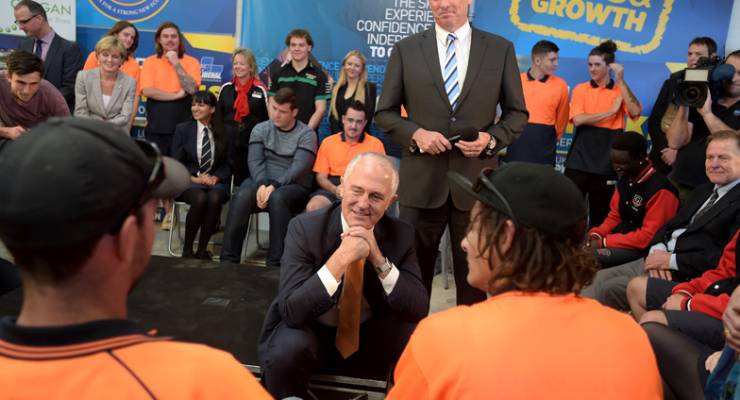
The Brexit outcome in the UK has led to considerable intergenerational finger-pointing about the “betrayal” of young Britons, who voted strongly to remain, by older people, who voted to leave in droves — and, in response, plenty of self-righteous justifications from Baby Boomers.
The problem with the narrative of Brexit as a Baby Boomer crime of indulgence and selfishness against the young is that it doesn’t quite square with the fact that young Britons could have made the result far closer if they’d turned out to vote, with less than 50% of under-25s voting last Thursday.
There’s a similar dynamic at play in Australia, despite our eccentric obsession with threatening people with sanctions if they don’t vote. As at the close of rolls, 420,467 Australians aged 18 or 19 were enrolled to vote, according to the Australian Electoral Commission. But that’s only 69% of the 18- to 19-year-old population of Australia at the end of 2015, according to Australian Bureau of Statistics data. In comparison, 74% of 20- to 24-year-olds are enrolled, 83% of 40- to 44-year-olds and 98% of 65- to 69-year-olds.
If young people enrolled at the same rate as middle-aged Australians, they’d bring nearly a quarter of a million extra votes to an election, and more than twice that if they enrolled at the same level as elderly Australians.
The issue is particularly significant at this election because there is more at stake for young people in this election than most. Back in April, Crikey outlined the multiple fronts on which young Australians are under economic attack from business and older Australians and the party most closely allied with those, the Liberal Party: climate change, housing affordability, the cost of education. While the Greens have long offered policies to address climate change and redress the taxpayer subsidies provided to housing investors via negative gearing, the 2016 election is unusual in Labor deciding to take the politically risky step of recommitting itself to carbon pricing (albeit with the details yet to be decided) and to reform of negative gearing, which even Treasurer Scott Morrison has admitted suffers from “excesses”.
On housing, in particular, both major parties have long served the interests of those already in the housing market and investors, directing tens of billions in taxpayer subsidies to investors to enable them to compete with young people and low-income earners to buy housing for investment purposes. Labor’s decision to restrict at least some of those taxpayer largesse to investors and slightly tilt the playing field back toward young people represents a major defection from that front in the war on young people. It has drawn strong opposition from business, News Corporation, the Coalition and vested interests like the property sector.
Similarly, on climate action, there’s a clear choice between a policy of inaction from the Coalition and a carbon price and investment in renewables from Labor (reverse the order of those two to describe the Greens’ policy). In contrast, on the cost of tertiary education, the Coalition has moved away from the status quo towards a US-style system of heavy graduate debt that would leave young people carrying a six figure debt load even before they try to get a mortgage.
The partisan alignments don’t always play out that way on other policy issues, however. Despite the constant evidence that future employment growth in Australia won’t come from traditional manufacturing but from services, Labor and the Greens remain obsessed with propping up old industries like steel, wasting taxpayer money and imposing higher costs on consumers and business. The Liberals at least have a better grasp of the fact that jobs growth will come in more innovative, more entrepreneurial, less traditional sectors — although Turnbull’s war on the NBN undermines their credentials on that front.
And none of the Coalition, Labor or the Greens have any sense of urgency about curbing Australia’s spiralling level of debt, with the return to surplus pushed off into the 2020s.
The grim reality for young Australians is, there is an intergenerational war being waged against them. And they’re losing. Climate change is accelerating while we do nothing. Housing anywhere close to major centres of economic activity is becoming a luxury item for which governments subsidise investors while young people struggle to compete. The Coalition came within a couple of Senate votes of deregulating university fees. The business community is pressing hard for penalty rates, which are of disproportionate benefit to young people, to be eliminated or cut. The government’s debt level steadily mounts and is headed to over 19% of GDP. We’re handing the next generation, and their children, a country that will have higher taxes, lower growth, more debt, poorer infrastructure, higher prices and lower demand as its citizens struggle to pay off mortgages accrued just for an education and a house, before they retire.
With that kind of future, under-enrolment by young people is an act of economic self-sabotage.








Bernard, you nailed it. To me, this is the turning point for young people. I have never felt so strongly about an election before. As a mother, I see my daughter with a huge HECS debt, on a nurse’s wage of $58,000 and who quite frankly will find it difficult to buy a house, etc. That is only part of what will face her in the future.
To me, the turning point is equality and social mobility for young people.
Quality education at primary, secondary, TAFE, University is THE driver for social mobility.
Labor is flawed in so many ways, but what their policies do is put a halt to the user-pays system for health and education that the Liberals are moving toward.
All parents and grandparents should look at their young in deciding who to vote for.
I will be voting for Labor this year – the first time in a long time
I used to think this but the yoof that avoided enrolling are right and they need not bother showing up. Who is actually promising to fix all these problems? They have been shown all their life that parliament is useless.
Younger Australians should note that today’s decision makers will all be dead by the time the climatic disasters really ramp up. That 20-year future will be while your children are still at school, and you are building their future. World leaders agreed (COP21) that their future must be zero-carbon, but making it happen is being left to you.
Be skeptical when today’s loudmouths assert that wind backed by gas will replace coal, oil – and gas. Instead, you can ask election candidates what they would do about achieving zero carbon. After all, they need your vote. Perhaps the most powerful thing you can do about it is to choose whom you vote for.
Angela is correct, Labor is at least trying and are on the right track to run the country to a prosperous future for young people. I think you are wrong re the steel industry (also the car industry), get out from behind your desk Bernard and have a look over the fence; a country needs good quality steel (being an island or two or three, poor quality steel rusts quickly), and as we are seeing hopefully a car industry may be adapted to build other products, even an aviation industry, who knows? Not all young people are suited to office work.
Re the steel industry: yes! That is what advocates here in Wollongong are getting at – sure there is a steel glut, mostly the result of overproduction by the Chinese, but the steel made here is top notch, lower in embodied carbon (thanks to collaborative research between Bluescope and UOW) and is given added value in the Zincalume plants and the many smaller fabricators but new road, rail and buildings are made with not necessarily better steel from Spain, China etc because of preferential arrangements with tender contractors. I’m tired of hearing about how we’re so hopeless at manufacturing etc when it is the ludicrous tender process and failure to mandate local content which leaves local industry high and dry. Why is manufacturing and innovation perceived as a zero-sum game? What is so strange about the wanting to commercialise and capitalise on Australian-led innovation and design? Which leads to the not-so-dud car industry (or rather, the potential and capacity in the former car industry).
Great article Bernard. As a baby boomer with early twenties kids that are trying to make a go of it, you are spot on. Oldies like me are getting too much Government subsidy while the young with their HECs fees, unaffordable housing and contract employment (read temporary exploitation) are facing a massive uphill task. The young are our future and we need to start making more investment in them!